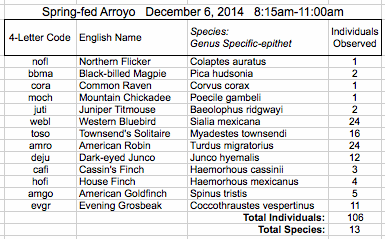
Plain List as PDF

Date: December 6, 2014
Location: Spring-fed Arroyo, Dixon
Number of Species: 13
Time: 8:15-11:00AM
Weather: Clear, calm.
Number of Observers: 2
Plain List (Scroll Down for Picture List):

Plain List as PDF
| English Name: Genus species: | Comments | Photos |
| Woodpeckers | ||
| Northern Flicker Colaptes auratus 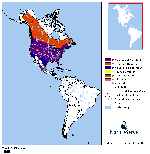 Enlarge Map External Sites: Cornell USGS Image Search | One of the most common birds in the valley. From below, shows red feather shafts in flight. The upper photo shows key marks: Black breast band. Red feather shafts on underside of wings and tail. Red mark under the eye indicates a male. Female (middle photo): no red face mark. Lower photo shows diagnostic white rump patch which is always visible in flight and sometimes visible when perched. Number of Individuals Observed:1 | 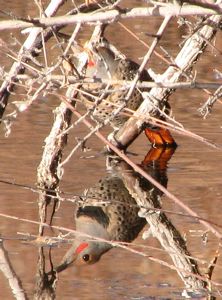 Cachanillas 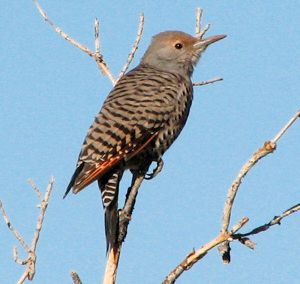 El Bosque 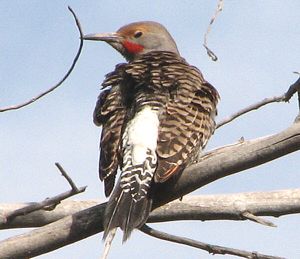 El Bosque |
| Jays, Crows and their Allies | ||
| Black-billed Magpie Pica hudsonia 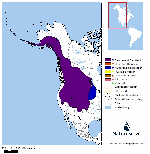 Enlarge Map External Sites: Cornell USGS Image Search | Unmistakable large black and white bird with very long tail. Number of Individuals Observed:2 | 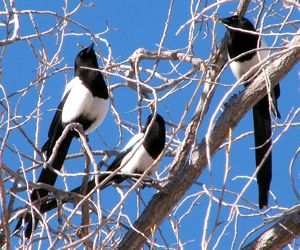 El Bosque |
| Common Raven Corvus corax 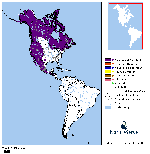 Enlarge Map External Sites: Cornell USGS Image Search | At times difficult to distinguish from American Crow. By sound, a throaty chortle or shout. In flight, the tail often appears wedge shaped. Ravens are often solitary, but sometimes appear with a few other individuals. Often soars like a hawk. Crows do not. Bill is thick and heavy. The throat is shaggy compared to the Crow. Breeding pairs perform synchronized flight high overhead. Number of Individuals Observed:1 | 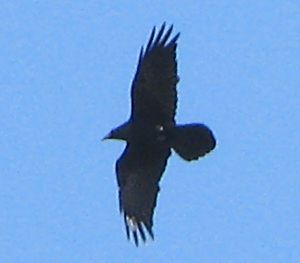 El Bosque 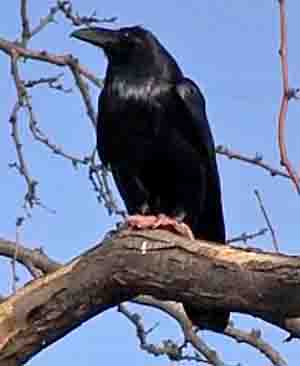 Camino de los Marquez, Santa Fe |
| Chickadees and their Allies | ||
| Mountain Chickadee Poecile gambeli 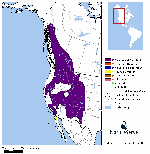 Enlarge Map External Sites: Cornell USGS Image Search | Very similar to Black-capped Chickadee in appearance and vocalizations. Mountain Chickadee has distinctive white eyebrow. Sound: Fee-bee-bee instead of fee-bee. Black on throat generally more extensive than shown here. Number of Individuals Observed:1 | 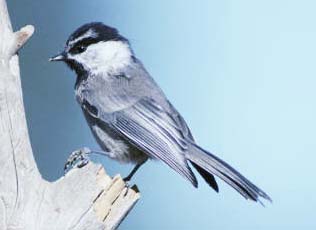 Photo: Dave Menke USFWS Oregon 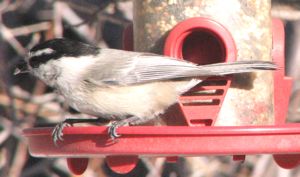 Dixon 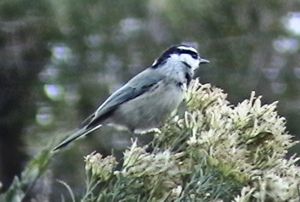 Pot Creek, Talpa, NM |
| Juniper Titmouse Baeolophus ridgwayi 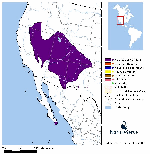 Enlarge Map External Sites: Cornell USGS Image Search | Generally seen in Juniper trees, the crest on the head is distinctive. Some of its vocalizations similar to Chickadee. Often detected by soft woodpecker-like tapping on branches. Number of Individuals Observed:2 | 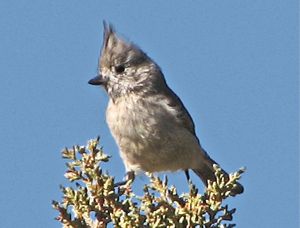 Camino Lejo, Santa Fe |
| Thrushes and their Allies | ||
| Western Bluebird Sialia mexicana 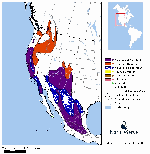 Enlarge Map External Sites: Cornell USGS Image Search | Male (top photo) has blue head and red breast. During breeding season, colors more intense than shown here. Female (middle photo) has blue in wings, but appears gray from front with a light buffy breast. Note white eye-ring. Juvenile on left in lowest photo. Female on right. Number of Individuals Observed:24 | 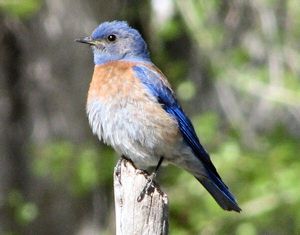 El Bosque 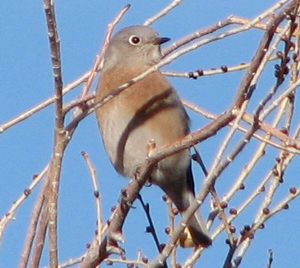 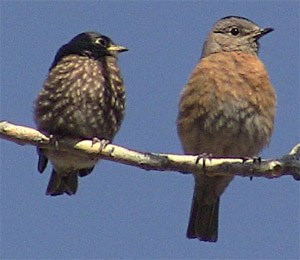 Rinconada Enlarge |
| Townsend’s Solitaire Myadestes townsendi 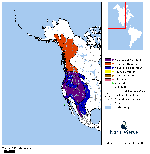 Enlarge Map External Sites: Cornell USGS Image Search | This bird is most often observed sitting in the tops of trees sounding a repeated, high, slow whistle. Gray all over with white on sides of tail. Fluttery in flight, with cream-colored bands running the length of each wing on the underside. Number of Individuals Observed:16 | 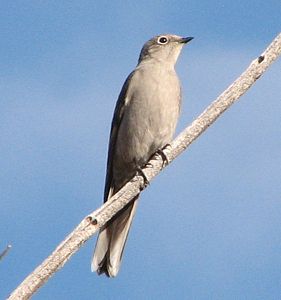 Harding Mine |
| American Robin Turdus migratorius 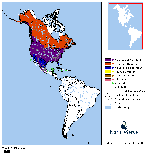 Enlarge Map External Sites: Cornell USGS Image Search | Best known American Bird. Note reddish breast, light colored bill and large white split eye-ring. Number of Individuals Observed:24 | 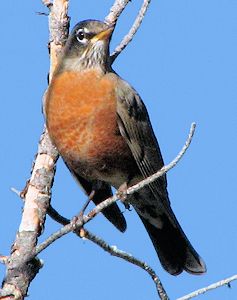 El Bosque |
| Sparrows and their Allies | ||
| Dark-eyed Junco Junco hyemalis 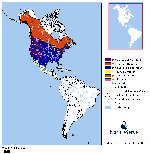 Enlarge Map External Sites: Cornell USGS Image Search | In winter, there are 5 sub-species of Dark-eyed Junco in our area. Many have a full black or gray hood. All have a dark eye set in dark plumage. Almost always in flocks of 10-20 individuals. Identifiable by a very "dry" sounding "tck-tck" and by white showing on the sides of the tail, especially in flight. Do a an Image Search (at left) to get an idea of the great variation in the plumage of this species. Number of Individuals Observed:12 | 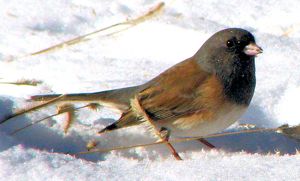 Dixon 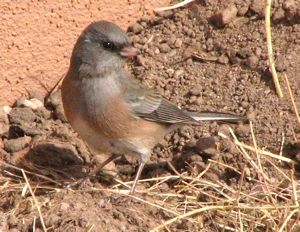 Dixon |
| Finches and Old World Sparrows | ||
| House Finch Carpodacus mexicanus 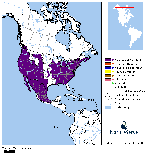 Enlarge Map External Sites: Cornell USGS Image Search | Often seen at feeders, this species is common in all habitats, especially agricultural areas. Male (upper picture) is easily identified by red plumage on head, throat, breast and rump. Female (lower photo) does not have red. Both sexes have streaking on breast, belly and flanks. Number of Individuals Observed:4 | 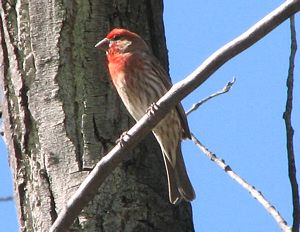 Arroyo La Mina 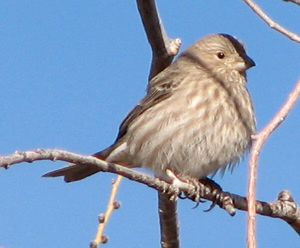 Arroyo La Mina |
| Cassin’s Finch Carpodacus cassinii 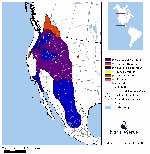 Enlarge Map External Sites: Cornell USGS Image Search | Very similar to House Finch. Female (Upper Photo) has cleaner, more well defined streaking than House Finch. Note white eyebrow. Male Cassin's (Lower Photo), unlike House Finch, is clear breasted. Cassin's has less extensive red than House Finch, but with a well defined red crown patch. Bill appears less curved than House Finch bill. Number of Individuals Observed:3 | 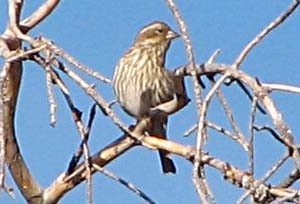 Dixon 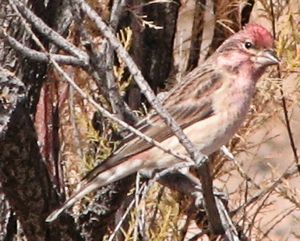 Dixon |
| American Goldfinch Carduelis tristis 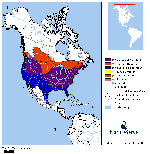 Enlarge Map External Sites: Cornell USGS Image Search | Female (Upper Photo) Male (Lower Photo) Number of Individuals Observed:5 | 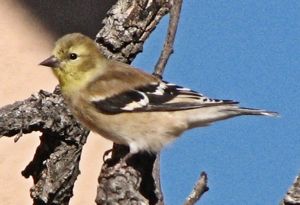 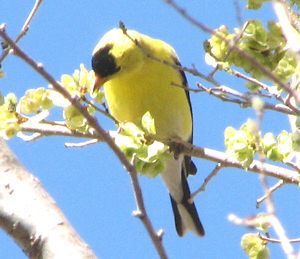 |
| Evening Grosbeak Coccothraustes vespertinus 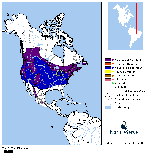 Enlarge Map External Sites: Cornell USGS Image Search | Number of Individuals Observed:11 | 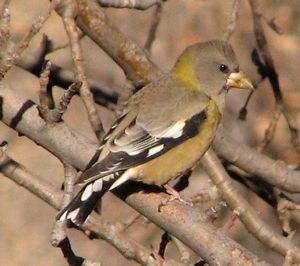 Dixon 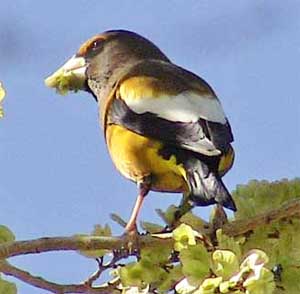 Paseo de Peralta, Santa Fe |